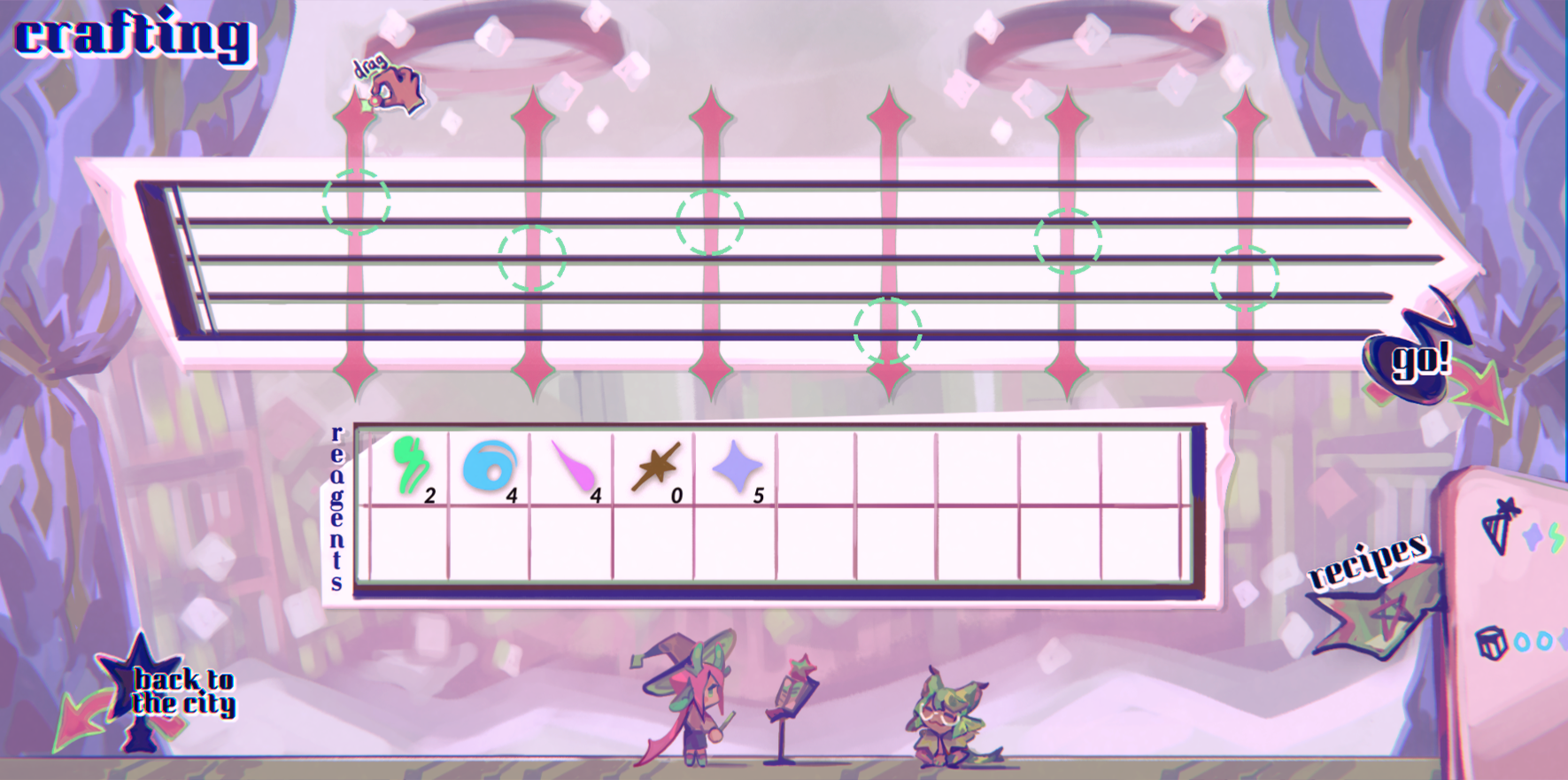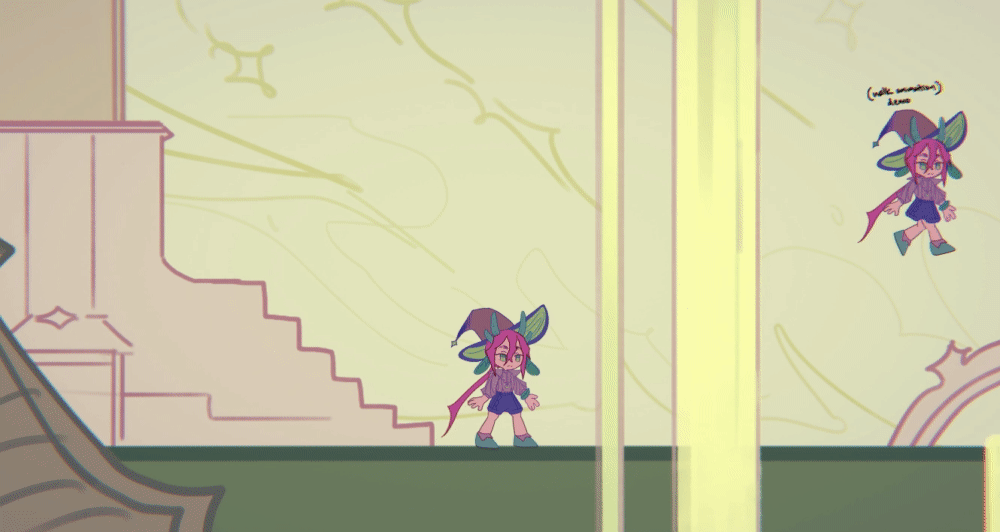Capella
A solitary note joins an ensemble.
Capella is a lighthearted platformer with crafting mechanics that submerges players into a fantastical world of rooftop traversal and musical instrument creation. Playing as a loner Witch who descends into the hectic chaos of the City below, the experience is divided into comfortable seclusion and challenging opportunities to experience human connection.
Can you find the courage to join the company of others?
Genre: Platforming, Crafting
Platform: PC & Mac, single-player
Engine: Unity
Team: 4 members.
Duration: September 2021 - March 2022
Roles & Contributions
Game Designer: platforming level design, exploration-crafting game loop, narrative design, prototyping, scripting.
Game Artist, UI/UX: character designs, ui/ux, all visual assets.
My Design process — Adversity and fuzzy feelings.
Systems of Serotonin: Game loop that surrounds the Player in magic: reagents to gather, instruments to summon, funny characters to grow close to.
Zoned Level Design: Platforming levels embody anxiety on a vertical spectrum with calm, freeing heights, and tension on the ground level.
Emotional Progression: Levels and crafting that progress at the Player’s own pace; whenever they want to push themselves to try something new.
Capella was created with the goal of being a lighthearted experience that hearkened back to nostalgic influences that my partner for this project and I both loved. Magical girls, frilly idols, bubblegum pop music, Maplestory, Animal Crossing (2001), and single-sitting flash games: a litany of formative media from the early 2000’s. We merged our interests and decided upon a few game seeds: a game about collecting and crafting items, a world with magical creatures like a Witch, and about sparking little joys with each little task the Player embarks upon.
However, it was imperative that the game have a sense of progression, especially when it was scoped to only have a 10-minute playtime. To this end, it’s my belief that in order to provide a moving experience, there has to be adversity. We created conflict by beginning the Witch as a loner, and decided our four mechanics, dichotomizing gathering/crafting against gifting/befriending: solitary activities and ones that require interfacing with others—self contained safety versus acts that expose oneself to the potential social disapproval, that require a certain level of bravery. Half the game is always enjoyable, but you cannot give away what you create or gain new recipes, you cannot complete the mechanical loop of the game and truly make the experience sing, without taking a scary step to interface with the other inhabitants of the game’s City.
This emotional contrast is also reflected this with the game’s map design. Most crafting reagents and visually impressive views are on the rooftops at the top of the map, while anxiety is created due to a distortion of the musical score depending on elevation and the camera angling making it difficult to know what is below at ground level where the cityfolk are. Through usability testing, we ensured the Player will be motivated by light narrative nudges, but also a desire to move against stagnation and see the game to its fullest, mechanically moving forward the game’s simple message of finding worth in human connection, even if doing so is frightening at first and takes hard work.
Prototyping.
I tested out quite a few mechanics as prototypes, including more tedious collecting and traversal mechanics that, while serotonin-inducing and playtime-expanding, would introduce too much potential for fatigue in players less resilient to grinding or busywork. It felt better to make crafting easy to execute.
On the topic of difficulty, I tested some prototypes where the Player used contextual clues like a character’s personality to give the ‘right’ gift, to inspire thoughtfulness when interacting with recipients and play to the social anxiety angle, but testing this prototype proved it was too ‘difficult’ and we found it weighed down the positivity of the experience.
Charm points were also tested out for features such as visual parallax on maps, spine animation, reagent physics, and click-and-drag map traversal. All-in-all we exited the prototyping phase with a solid grasp on what mechanics would be the most lighthearted and endearing.
Lessons Learned.
What went well.
On a production note, we successfully finished the game. It begins, progresses, and ends on a solid note both mechanically and narratively—we accomplished what we set out to do and made a fascinating game with a wholesome charm. I am happy with the systemic game loop we were able to implement and how it weaved into the emotional experience, and believe this is a promising game ‘demo’ that could easily be polished and mechanically deepened in each of its pillars to make a longer game that would warm the hearts of many.
Also, this is neither here nor there, but the decision to distinguish our crafting system by placing reagents on a musical staff was a contribution of mine I was very delighted by!
Areas of improvement.
I learned quite a lot about platforming and level design through this project. Everything from tweaking colliders to velocity and gravity variables to achieve a level that was fun to traverse multiple times, even with the work I’ve put in, it is easily the aspect of design that needs the most overhaul to really up the ‘fun factor’ of it. Due to the sheer scope of the features and narrative sequences we desired, we could not spend too much time on platforming, nor the crafting, gifting, or social mechanics, and in my future work I think I will be careful about feature volume and prioritize the quality of at least one mechanic.
Closing thoughts.
What a game to be proud of! Considering it was fully developed in under 6 months, it is truly a marvel we were able to develop it to the level it reached, and it feels complete as a system and as a story. A great deal of experience was also gained by crafting platforming levels, designing a sandbox narrative, drawing and animating every single visual asset in the game, and of course designing its overarching mechanical system. Many lessons were learned about scoping a game that I will be carrying forward into my future developments, such as using a burndown as a predictive tool, triaging darling features that may glut up a schedule. Onto the next project!







